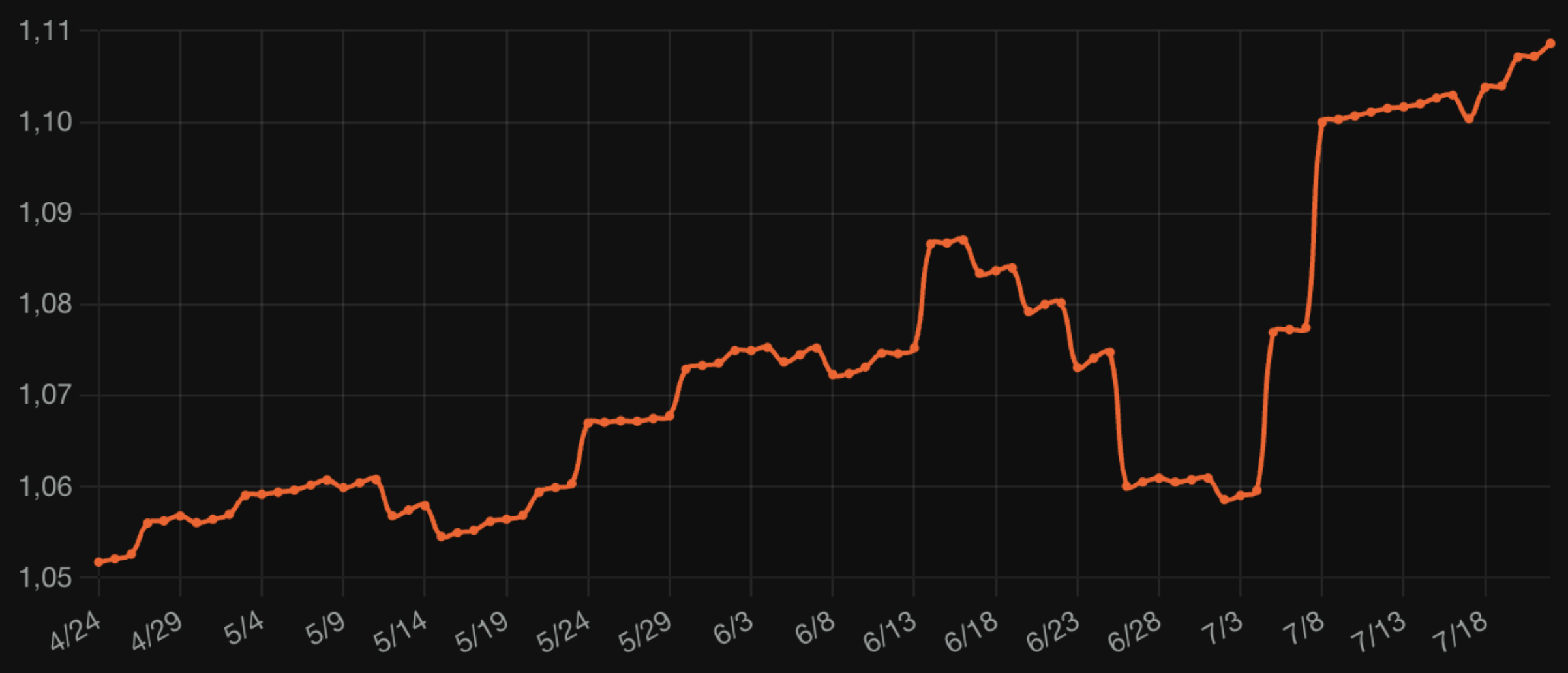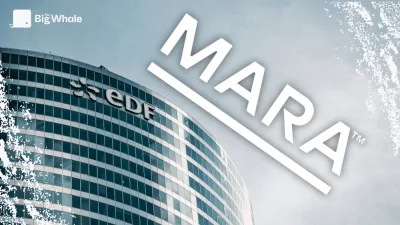TBW - Ostium: Hyperliquid's competitor aims to link DeFi to traditional markets

What you need to know before you start
Ostium is a decentralised trading platform built on Arbitrum. It mainly offers trading in perpetual contracts on traditional financial assets: commodities, currencies, corporate shares or even indices such as the S&P 500.
Unlike most decentralised platforms that rely on an order book, Ostium relies on a liquidity pool and oracles to ensure market depth from launch.
General presentation
Ostium is positioned as a decentralised trading protocol offering leveraged access to both traditional financial assets and the most liquid cryptocurrencies. The aim is to open up access to global markets while exploiting the advantages specific to the blockchain: international accessibility, continuous operation, interoperability with other applications and transparency over funds.
The protocol runs on Arbitrum, a layer 2 of Ethereum that enables a block to be produced every 250 milliseconds. This choice aims to offer a fluid experience and limit the friction associated with repeatedly signing transactions.
On the trading side, Ostium allows leverage of up to 100 for most assets, and 200 for currencies. However, when traditional markets are closed, a mechanism automatically limits leverage to 10. To manage these periods, Ostium has introduced a product called "0DTE perps" (0 day to expiry perps), a hybrid between perpetual and expiry products, enabling a position to be held open without an expiry date while respecting the closing times of traditional markets.
Users can also provide liquidity via the OLP pool (Ostium Liquidity Provider). This pool applies an automated market-making strategy, collecting trading fees and liquidations. In return, it sometimes acts against traders when their positions do not balance, which can generate losses if the majority of traders are winning.
This model, popularised by GMX, relies on oracles to obtain asset prices. Rather than recreating an order book and market depth ex nihilo, Ostium relies on Stork and Chainlink to retrieve prices where liquidity is highest.
>> For a more in-depth look at oracles, our analysis is available here.
This operation brings Ostium closer to traditional brokers such as eToro or Plus500, which act as a counterparty to their users without seeking to compete directly with stock exchanges such as Nasdaq.
Ostium is introducing an experimental mechanism called "strategies". These are automated orders triggered when certain predictive market probabilities on Polymarket reach a given threshold. The idea is to allow traders to position themselves upstream when an event likely to influence the price of an asset becomes probable.
>> To find out more about Polymarket, read our dedicated analysis.
Financing
Ostium raised $3.5 million in October 2023. The round brought together Balaji Srinivasan, Susquehanna International Group, General Catalyst and LocalGlobe. The funds were used to finance the development of the platform and launch its first user acquisition campaigns.
Team
Ostium Labs is led by Kaledora Fontana Kiernan-Linn. With a degree in neuroscience and statistics from Harvard, she worked briefly at Bridgewater as an investor before embarking on the creation of Ostium.
Alongside her, Marco Antonio Ribeiro holds the position of technical director. Trained in engineering sciences at Harvard, he has also held investment positions at Bridgewater. Their shared experience in an institutional financial environment marks the approach of the project, which seeks to bring the standards of traditional finance closer to the on-chain universe.
Community support
The Ostium community now has just over 50,000 subscribers on X and 21,000 members on Discord. The project's visibility has recently increased thanks to a campaign with Kaito aimed at strengthening its presence on X. The team is building on this momentum to create a core of active users around the platform.
Functioning
Ostium is moving away from the GMX v1 model, where the liquidity pool serves directly as a counterparty to all traders. The protocol introduces a two-tier structure: a liquidity pool and a market making pool.
The liquidity pool is used primarily to settle trades. It provides the funds needed for winning trades and accumulates losses on losing trades. It is also used to balance open interest when the majority of positions are moving in the same direction. It is only when this reserve is out of balance or depleted that the liquidity deposited by users in the market making pool (MMP) is called upon. In this case, liquidity providers may incur losses if the majority of traders are profitable.
PLO participants receive 50% of the position opening fees and 100% of the liquidation fees. When the liquidity pool is under-collateralised, their share of the opening fees increases, providing an additional incentive to support the protocol.
Business model
Ostium's model relies primarily on fees paid by users to open their positions as well as rollover fees applied to non-crypto assets. Part of this revenue is redistributed to the PLO's liquidity providers.
This system allows Ostium to get off the ground without having to commit a massive amount of its own capital to seed the protocol's liquidity. The challenge remains to attract a sufficiently active user base to generate a regular trading volume, an essential condition to ensure the viability of the model.
In fact, the launch of a points campaign at the beginning of April has had a direct impact on trading activity, as evidenced by the increase in weekly volumes on the platform.

Airdrop and points campaign
Since the beginning of April, Ostium has launched a campaign that distributes 500,000 points to users every week. These points are allocated according to trading volume and liquidity deposited in the OLP pool. For the moment, no information has been given on the total duration of this campaign.
The platform's first users have also benefited from a retroactive distribution of 10 million points. Although nothing has been confirmed, these points should be an important criterion in a possible airdrop of Ostium's future token.
Partnerships and ecosystem
Ostium relies on Arbitrum, a layer 2 of Ethereum where DeFi activity is already well developed. OLP has not yet been integrated into the main lending protocols on the blockchain, but discussions in this direction are planned. The aim would be to facilitate the use of PLO deposits as collateral and increase their liquidity in the ecosystem.
Limits and risks
Ostium's main challenge will be to maintain sustained activity after the end of its points campaign. The ecosystem of decentralised perpetuals is highly competitive, and several protocols are currently running similar campaigns. This dynamic often attracts "mercenary capital" that quickly migrates from one platform to another depending on the rewards on offer.
The liquidity pool model also carries risks. If the majority of traders close their positions with a gain, the PLO may incur losses. In addition, liquidity withdrawals are subject to a delay of several days, which may limit the appeal for some providers.
Despite this, the data observed so far shows that deposits in the PLO have generally grown, with annualised returns fluctuating between 15% and 30%.

>> Hyperliquid: are the criticisms justified?
Regulatory compliance
At present, there is no specific regulatory framework for decentralised trading platforms like Ostium. However, this situation could change. If the authorities were to consider these protocols as brokers, they could be subject to obligations comparable to those of traditional financial intermediaries. This uncertainty remains a risk factor for the development of the project.
Competition
The DEX market specialising in perpetual contracts has seen a new surge since the rise of Hyperliquid, which now accounts for more than half of the sector's volumes. But Hyperliquid focuses mainly on cryptocurrencies and offers very few traditional financial assets, apart from gold.
This positioning leaves room for players such as Ostium, whose strategy aims to broaden access to traditional assets.
There have been other attempts in the past, notably with Gains Network, a pioneer in the sector as early as 2021. However, the protocol gradually lost relevance due to technical limitations and an incomplete user experience. Ostium, which uses a similar architecture based on a liquidity pool and oracles, is seeking to correct these weaknesses while introducing its own products, such as "0DTE Perps", suitable for leveraged trading on markets that are not continuously open.
>> Hyperliquid, dYdX, Jupiter, Vertex: the comparison of the best DEX Perp
Roadmap
Ostium plans to regularly expand its catalogue of assets, particularly in traditional financial markets. The liquidity pool is currently being redesigned. It should result in two distinct vaults:
- a first, passive vault, dedicated to settling transactions, with a predictable return and limited risk;
- a second, active vault, designed to balance the platform's positions, with a higher but more volatile return.
In the longer term, Ostium could also allow holders of tokenised financial assets to provide liquidity directly to the platform. Such a development would strengthen the synergy between traditional markets and DeFi, while broadening the sources of liquidity.
The Big Whale's view
Ostium stands out for its approach, which is close to that of traditional brokers such as eToro or Plus500, but in an on-chain version. Users can not only trade in front of the platform, but also choose to become a counterparty themselves via the PLO. The protocol provides complete transparency, instant deposits and withdrawals, as well as native integration with the Arbitrum ecosystem.
However, the project faces a number of challenges: maintaining solid activity after the end of its airdrop campaign, establishing itself in a highly competitive sector and proving the robustness of its infrastructure over time. However, its focus on traditional financial assets gives it a differentiating position. With less than a year to go before its launch, Ostium still has plenty of room for improvement.
Better integration with Arbitrum's DeFi, in particular via the use of OLP as collateral on other protocols, could be a major growth driver. Ostium will also need to demonstrate its ability to build user loyalty beyond the mere incentive of points rewards, which is essential if it is to become a long-term player.
>> HyperEVM: a network under construction backed by an on-chain trading giant



